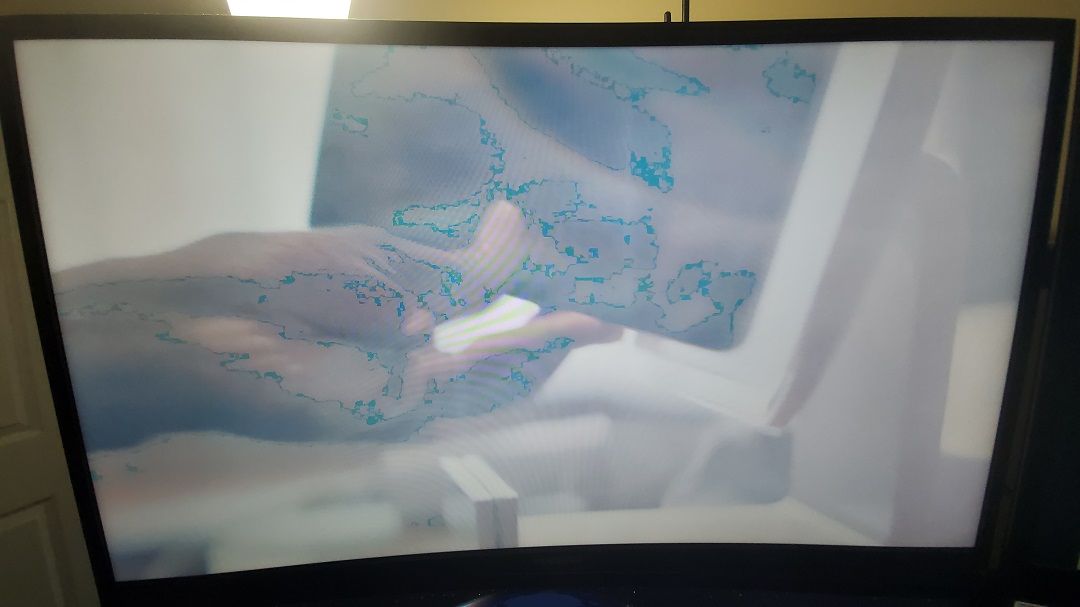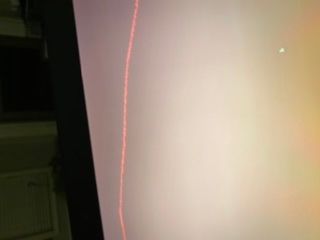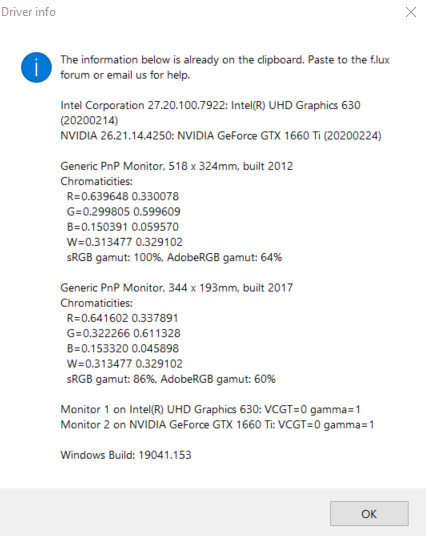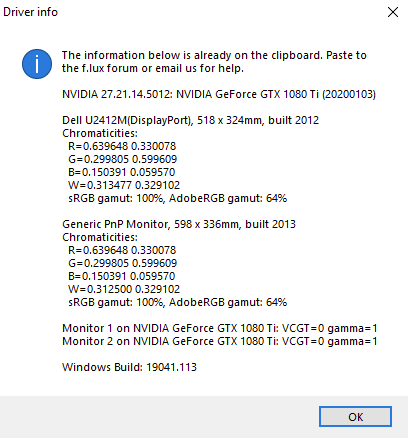Red Screen Artifacts When flux is on
-
I'm getting the same artifacts on a new Surface Pro 7. Here's mine:
Intel Corporation 25.20.100.7101: Intel(R) Iris(R) Plus Graphics (20190805)
Surface Panel Filter, 260 x 173mm, built 2016
Chromaticities:
R=0.639648 0.330078
G=0.299805 0.599609
B=0.150391 0.059570
W=0.313477 0.329102
sRGB gamut: 100%, AdobeRGB gamut: 64%Monitor 1 on Intel(R) Iris(R) Plus Graphics: VCGT=0 gamma=1
Windows Build: 18362.295
I noticed you're also on Iris Plus graphics. Maybe it has something to do with that?
-
This post is deleted! -
I get the same sort of weird artifact outlines in videos that appears to be caused by using f.lux, although mine are of a blue color.

My video card is a MSI NVIDIA Geforce GTX 1660 TI VENTUS XS 6G OC. I have 4 monitors connected to it, 3 on DisplayPort and 1 on HDMI. Oddly, it only affects two monitors, the HDMI one and one of the DisplayPort ones. I can temporarily fix the issue (until a reboot) by unplugging any of the 4 monitors and plugging it back in, or by using a Monitor Off Utility https://download.cnet.com/Monitor-Off-Utility/3000-20432_4-10967806.html to have the monitors sleep and then move the mouse to bring the monitors back up.
Drove me crazy trying to figure out the cause of the issue. I had tried a different video card (Gigabyte one with also NVIDIA chipset), replaced all the cables, reinstalled drivers, tried messing with every video setting that I could think of that might be related. Then for some reason I finally thought about f.lux, disabled it from starting with Windows, and the problem was gone. As soon as I manually start f.lux, the blue artifacts appear.
-
Same problem here with my new Surface Laptop 3.
Its running the 1035G7 (so GPU is Iris Plus)
I tried using Windows 10 own blue light filter but its a mess.
EDIT: I even get artifacts during web browsing, usually brown/red dots on photos, so its not just videos.
-
I'm getting the blue as well. It's an edge case - if you watch the artifacts when you change from nighttime to day, they will (dis)appear as it rotates the colors. The program isn't catching when there's an overflow situation, and so it goes from black to blue (white to red, I assume?). This is a pretty standard bug, should be easy enough to fix.
-
So now based on everyone's responses, it seems like there indeed is a bug in f.lux. Does anyone know the best way to get visibility of the issue to the developers? I don't see a way to submit a bug report or issue within the f.lux application or the website, and have no idea if the developers read this forum with an open ear for bugs and issues. I emailed the support email, so we'll see if that does anything.
If this issue is affecting you, please upvote the original post to this thread, that seems to be what shows up on the main thread page for registered votes of the thread.
Hoping for a bug fix, had to stop using it due to this. Now using the Windows 10 night mode feature, but it really lacks customization options in comparison to f.lux
-
I just got the Surface pro 7 and have noticed the same weird things popping up on my screen when it’s set to the more orange setting.

-
This post is deleted! -
@apreslin said in Red Screen Artifacts When flux is on:
So now based on everyone's responses, it seems like there indeed is a bug in f.lux. Does anyone know the best way to get visibility of the issue to the developers? I don't see a way to submit a bug report or issue within the f.lux application or the website, and have no idea if the developers read this forum with an open ear for bugs and issues. I emailed the support email, so we'll see if that does anything.
If this issue is affecting you, please upvote the original post to this thread, that seems to be what shows up on the main thread page for registered votes of the thread.
Hoping for a bug fix, had to stop using it due to this. Now using the Windows 10 night mode feature, but it really lacks customization options in comparison to f.lux
No response from email after about a month, not sure how to contact the developer(s).
-
Tweeted this out to the f.lux Twitter account https://twitter.com/apreslin/status/1220409689835474944
@apreslin said in Red Screen Artifacts When flux is on:
@apreslin said in Red Screen Artifacts When flux is on:
So now based on everyone's responses, it seems like there indeed is a bug in f.lux. Does anyone know the best way to get visibility of the issue to the developers? I don't see a way to submit a bug report or issue within the f.lux application or the website, and have no idea if the developers read this forum with an open ear for bugs and issues. I emailed the support email, so we'll see if that does anything.
If this issue is affecting you, please upvote the original post to this thread, that seems to be what shows up on the main thread page for registered votes of the thread.
Hoping for a bug fix, had to stop using it due to this. Now using the Windows 10 night mode feature, but it really lacks customization options in comparison to f.lux
No response from email after about a month, not sure how to contact the developer(s).
-
Thank you for the posts - it looks like Intel has released a new driver for Iris Plus with a January 2020 date. Can anyone try it out?
We often see problems in "hybrid" setups when the discrete GPU (e.g., NVIDIA) version gets too far ahead of Intel's driver. Only a guess here, but I do know several things have been changing in Windows color to support HDR.
-
@herf Thanks for the response. I made a 2 minute YouTube video https://www.youtube.com/watch?v=xq0usnYwz80 (listen with sound on of me describing the issue) which shows the problem. I don't have Iris Plus or any discrete GPU enabled, only a PCIE NVIDIA GeForce RTX 2060 with the latest drivers version 26.21.14.4187 dated 12/24/2019. That GPU has quad monitors connected to it, 3 of them on DisplayPort and one on HDMI. This also happened on a different video card in the same system, a NVIDIA GeForce GTX 1660, so it doesn't seem to be something like a defective video card. I also tried swapping out cables, and that didn't make a difference.
Any thoughts on what might be the issue with f.lux in that setup that's causing the cyan colored artifacts in video?
NVIDIA 26.21.14.4187: NVIDIA GeForce RTX 2060 (20191224)
Generic PnP Monitor, 598 x 336mm, built 2016
Chromaticities:
R=0.645508 0.336914
G=0.328125 0.615234
B=0.146484 0.055664
W=0.313477 0.329102
sRGB gamut: 85%, AdobeRGB gamut: 60%Generic PnP Monitor, 598 x 336mm, built 2016
Chromaticities:
R=0.645508 0.336914
G=0.328125 0.615234
B=0.146484 0.055664
W=0.313477 0.329102
sRGB gamut: 85%, AdobeRGB gamut: 60%Generic PnP Monitor, 598 x 336mm, built 2016
Chromaticities:
R=0.645508 0.336914
G=0.328125 0.615234
B=0.146484 0.055664
W=0.313477 0.329102
sRGB gamut: 85%, AdobeRGB gamut: 60%Generic PnP Monitor, 598 x 336mm, built 2016
Chromaticities:
R=0.645508 0.336914
G=0.328125 0.615234
B=0.146484 0.055664
W=0.313477 0.329102
sRGB gamut: 85%, AdobeRGB gamut: 60%Monitor 1 on NVIDIA GeForce RTX 2060: VCGT=0 gamma=1
Monitor 2 on NVIDIA GeForce RTX 2060: VCGT=0 gamma=1
Monitor 3 on NVIDIA GeForce RTX 2060: VCGT=0 gamma=1
Monitor 4 on NVIDIA GeForce RTX 2060: VCGT=0 gamma=1Windows Build: 19033.1
-
@apreslin so this is the insider build? Nice setup :)
I saw artifacts on the top two monitors but not on the bottom two - are you seeing on all?
Also, do they go away if you unplug HDMI and only use DisplayPort?
-
@herf It is an insider build, but I'm pretty sure this issue was happening before I changed over to an insider build. Yeah, go big with quad 27" monitors or go home :)
The artifacts only occur on 2 of the 4 monitors for some reason.
I just tested with different combinations. With only 3 monitors connected, I can't reproduce the artifacts at all.
Tried all 3 on DisplayPort with no artifacts.
Tried 2 on DisplayPort, 1 on HDMI, no artifacts.
Connected all 4 back up, artifacts appear when f.lux is started.So the only way I seem to have the issue is when it's connected to all 4 at once. The other interesting thing about the issue is that is always affects 2 of the 4 monitors, but not always the same 2. Also, it's not always the HDMI connected monitor being one of the two monitors that have the artifacts.
-
I've been having the exact same issue since I got my laptop late last year. My presumption was that it had something to do with the HDR nature of my display? But that could definitely be wrong from what I am reading here. Let me know if that lines up with anyone else.
-
Same here, MSI GS65 with GTX 1660Ti. Blue artifacts only on external display. For me it seems to happen only if I have one external monitor, if I connect second (different model) I can't reproduce the issue. Happens on both monitors (if only one connected). Neither has HDR so that's not the issue, at least not in this case.

-
Same problem here - two displays connected to GTX 1080Ti, weird artifacts (like in this post: https://forum.justgetflux.com/post/22665) on one screen. If a third screen is connected, the artifacts show on one screen only, but not the same as with two displays connected. No HDR displays.
All of this is instantly remedied by toggling Night Light on and off and then it doesn't appear until a restart.

-
@herf Would you be able to take another look at this thread now that more people are reporting that they are experiencing this bug? Also tweeted at https://twitter.com/apreslin/status/1220409689835474944 at @JustGetFlux
-
@apreslin Most of these issues (in Insider builds) should be reported to Microsoft also. Usually they are some combination of driver bugs and bugs internal to Windows. It does help if you post "driver info" here so we have a record of when things broke.
Mostly we just forward them on, because they are bugs in the color system. Can you report them through "Feedback hub" from Windows?
-
Reported the bug to MS through Feedback Hub as advised. Available here: https://aka.ms/AA88icf